Favorites from the LPSC 2017 conference
A couple of weeks ago, I returned from the 2017 Lunar and Planetary Science Conference (LPSC) in Houston. This is one of the major international events where planetologists, astronomers, representatives of space agencies and universities from around the world talk about new research and plans for the future.

After reading a couple of hundred reports and poster presentations, here I want to share a summary of the works that seemed interesting.
Disclaimer (disclaimer). I am a physicist by education, but still not a specialist in planetology. My selection of material is certainly subjective and incomplete. My interpretation of the work may be erroneous. If for you such things as finances, work, or professional reputation depend on its accuracy, then it is better to get in touch with the authors and recheck everything with them directly. Their contacts are listed in the abstracts of works under the links. Amendments from readers, of course, welcome.
So let's go!
')
TRANSIENT BROAD SPECULAR REFLECTIONS FROM TITAN'S NORTH POLE
The brilliance of the Sun in the lakes of Titan has been photographed for quite some time:

[Sun glare on Titan. Image Credit: NASA]
However, more recently, similar reflections have begun to be noticed where there are no lakes. Moreover, they are impermanent. Today sparkles, in the next span with a very similar geometry - no longer. What's the matter?
To explain the hypothesis of "wet asphalt". Imagine that a methane rain has passed over a slightly rough terrain. "Asphalt" is wet and shiny. To the next Cassini passage above the terrain, it dried out and no reflections were observed:

--- === ---
METHANE, ETHANE AND NITROGEN LIQUID STABILITY ON TITAN
Continue about the hydrosphere of Titan. Developed with seas and rivers. True, the prefix "hydro" is not quite appropriate here, because there is no water in those seas, but they are filled with liquid methane (CH 4 ), ethane (C 2 H 6 ) and nitrogen (N 2 ). It is not very clear only in what proportions and how these substances generally interact in the conditions of Titan. What and work. Quite a lab.
The authors took these three gases, cooled them to cryogenic temperatures, and began to watch how they mix and when they freeze, depending on concentrations and pressures. And they found things in the light of which Titan's hydrosphere looks like a much more complex system compared to the Earth’s oceans. However, if you have three “waters” and three different ice instead of one, then something like this should have been expected.
Methane-ethane mixture freezes with a more severe frost than each of the gases separately. That is, these gases work as mutual antifreeze.
When this mixture freezes, the methane ice floats to the surface, while the ethane sinking and sinks to the bottom. Which is formed first - depends on the initial concentration.

[Photo of an experimental camera from work. On the left - ethane ice at the bottom of the liquid mixture. On the right - methane on its surface. Image Credit: J. Hanley, L. Pearce, G. Thompson, W. Grundy, H. Roe, G. Lindberg, S. Dustrud, D. Trilling, S. Tegler / Lowell Observatory, Flagstaff, AZ; Northern Arizona University, Flagstaff, AZ; University of Texas, Austin, TX.]
Further, the ingress of nitrogen into the mixture (just from the atmosphere) can raise the melting point of the mixture, and, accordingly, lead to its unexpected freezing. By the way, in another work it is shown that nitrogen is well dissolved in methane - but it is bad in ethane. Thus, the evaporation of a part of methane from a liquid can cause a sudden “boiling up” of the sea. Some kind of cryogenic champagne with nitrogen bubbles.
Finally, the most interesting. At pressures of more than 2.5 atmospheres (corresponding to depths of more than ~ 100 meters on Titanium), the methane-ethano-nitrogen mixture is divided into two liquid phases. The report was a terrific video, but here you’ll have to limit it to a not very good picture:

[Image Credit: J. Hanley, L. Pearce, G. Thompson, W. Grundy, H. Roe, G. Lindberg, S. Dustrud, D. Trilling, S. Tegler / Lowell Observatory, Flagstaff, AZ; Northern Arizona University, Flagstaff, AZ; University of Texas, Austin, TX.]
Top - gas. Below it is the first liquid phase, rich in ethane. Under it - the second, rich in nitrogen. And on the "ceiling" of the first phase there is a tiny hint of a drop. This is the second phase condensate. Which is the real drops, like oil in water, flows through the first light into the second.
Imagine a double-layered sea? So do I.
After the report, I thought about this. The terrestrial oil industry has long been engaged in cryogenic separation of associated gases. Of which the very first - just methane with ethane. Well, nitrogen and the atmosphere is full. So, perhaps, people are already familiar with all these interesting effects in oil refining. It is difficult not to pay attention to the suddenly frozen (from nitrogen) pipeline. But if this is so, then surely all these studies are deeply closed corporate secrets ...
--- === ---
CLASSIFICATION OF LABYRINTH TERRAINS ON TITAN
The labyrinths of Titan are plateaus, cut by a complex system of valleys and ridges, visually resembling the bark of a tree:
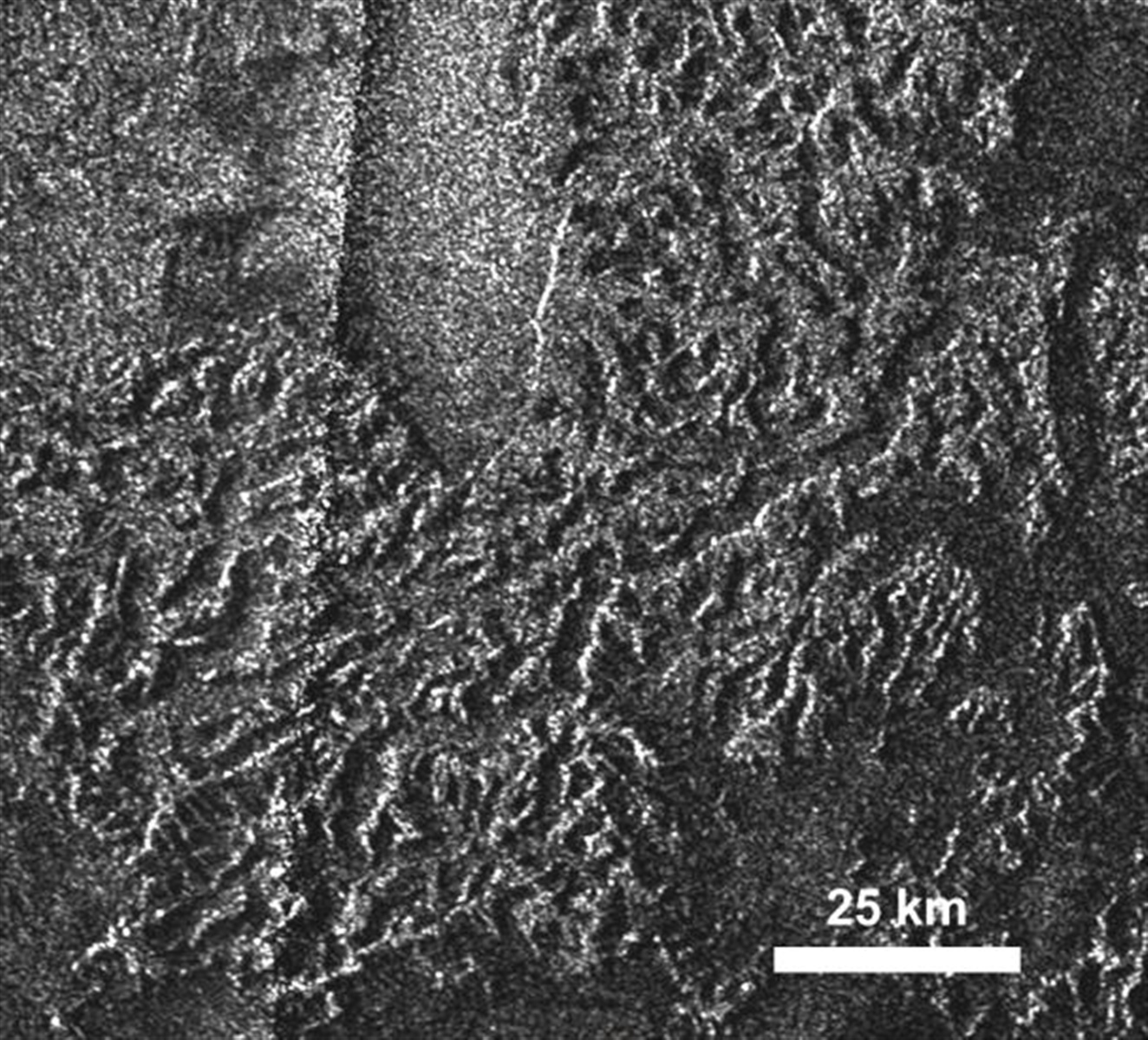
[Image Credit: NASA / JPL]
Their nature is not quite clear. At first glance, they look like river beds - and we know that there are rivers on Titan. But, looking more closely, you can see that some of these “labyrinths” are closed. They do not flow from anywhere and nowhere.
So at least part of the labyrinths are not a river bed? The authors took up morphological analysis and concluded that some of these formations are supposedly ... karst ! But what exactly causes them - whether the material is dissolved by underground flows, flushing or evaporation - remains unknown.
Do not labyrinth plains on Titan consist of such gullets?

--- === ---
TOPOGRAPHIC ASSESSMENT OF HOLLOWS ON MERCURY: DISTINGUISHING AMONG FORMATION HYPOTHESES
Since we are talking about karst , it makes sense to transfer to Mercury. Mysterious pits ("hollows") on it, too, have not been properly explained yet. But one hypothesis says that these are ... karst too. Formed by the evaporation of some volatile substance under a layer of dust and regolith.
So they look like this:
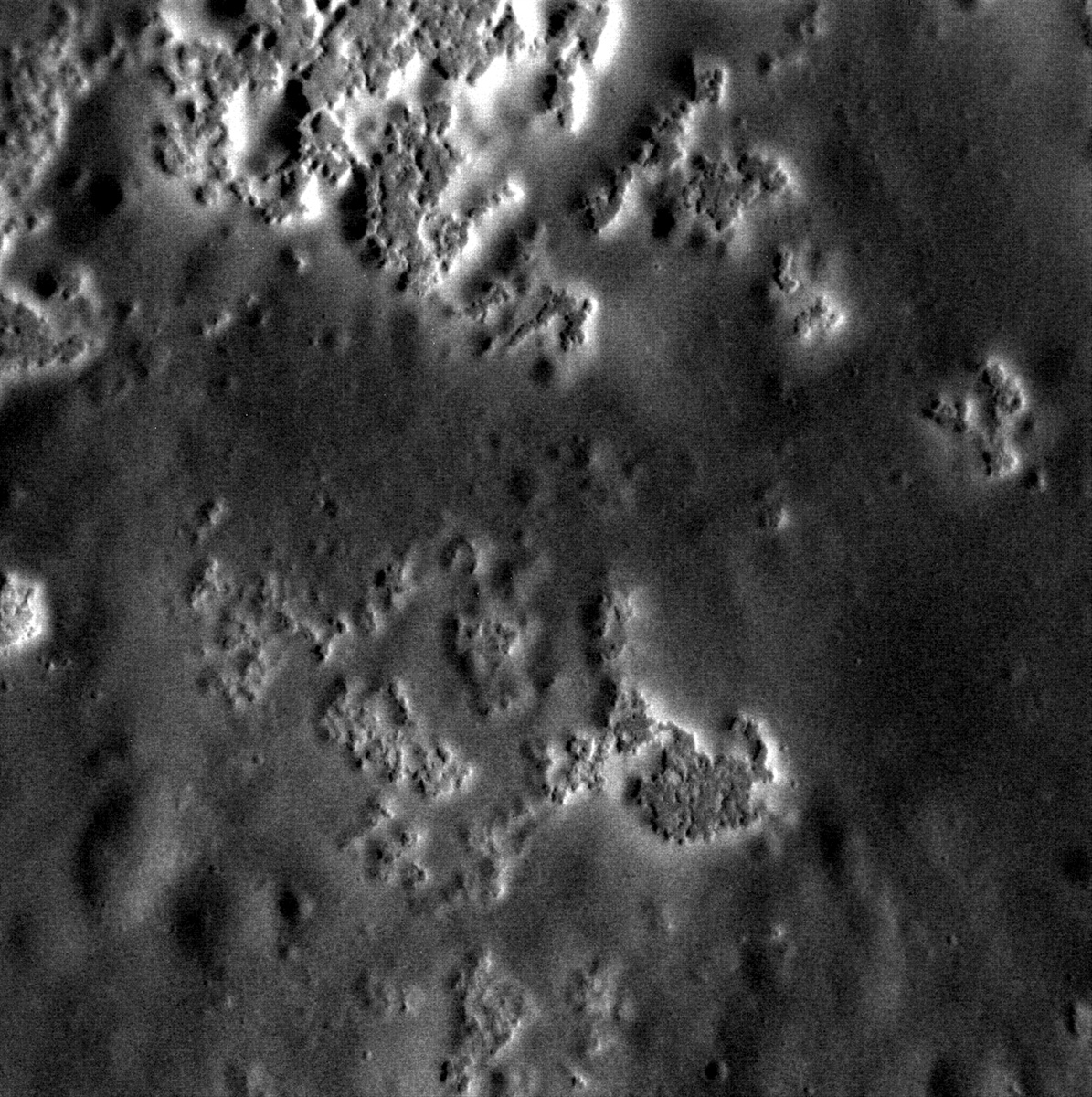

[Pits on Mercury. Yes, in these spots one should try to see the pits, not the protrusions, and in the rounded mounds - concave craters. Sometimes the rotated picture helps, so I added this. Image Credit: NASA]
We do not know what this material is. And I don't even know if the hypothesis is true. In this paper, I just liked the pictures. Good, beautiful photos of "pits", collected by the authors for the purpose of their classification and submitted to the public. The numbers I wrote down. And may the authors forgive me, one laid out, slightly with the photo shop to raise the contrast. In my defense, I note that the pictures on the presentation also looked much better than the originals from the site MESSENGER.

[Image Credit: NASA / JPL]
--- === ---
OXYGEN DEPLETION ON THE SURFACE OF MERCURY: EVIDENCE OF SILICON SMELTING?
Having spent 4 years in orbit around Mercury, the MESSENGER apparatus was able to measure the content of the main mineral forming elements (O, Si, Ti, Al, Cr, Fe, Mn, Mg, Ca, Na, K, S, Cl) in the surface of the planet.
True, the device sees only the concentration of atoms, and not the chemical bonds between them. To estimate the mineral composition, all metal elements are usually assumed to be fully oxidized. That is, silicon, for example, is present as SiO 2 , aluminum as Al 2 O 3, and the like. From the resulting oxides, then, as a constructor, minerals make up (for example, calcium silicate Ca 2 SiO 4 is 2 * CaO + SiO 2 ).
Everything is good, but for Mercury this is not working. The balance of oxygen does not converge. It is not enough to oxidize everything that is oxidized, retaining the measured ratio of oxygen to silicon O / Si = 1.4 ± 0.03 (and even less, as stated in the work).
In an attempt to explain this inconsistency, a hypothesis was advanced: in the depths of Mercury, a kind of “metallurgical smelting” of pure silicon from quartz and graphite occurs, which, as we strongly suspect, makes up a few percent of the planet's crust.
If this is true, then 12.6–17.9% (by weight) of the surface of the northern hemisphere of Mercury should be formed of metallic silicon or its alloy with iron.
What is interesting? Well, firstly, non-oxidized silicon as a rock-forming substance is unusual. Secondly, on all other stony bodies (Moon, Earth, Mars) oxygen is in excess and everything that can in principle be oxidized by it, oxidized for a long time. Why is it suddenly not so well-done by the sun of Mercury? Riddle.

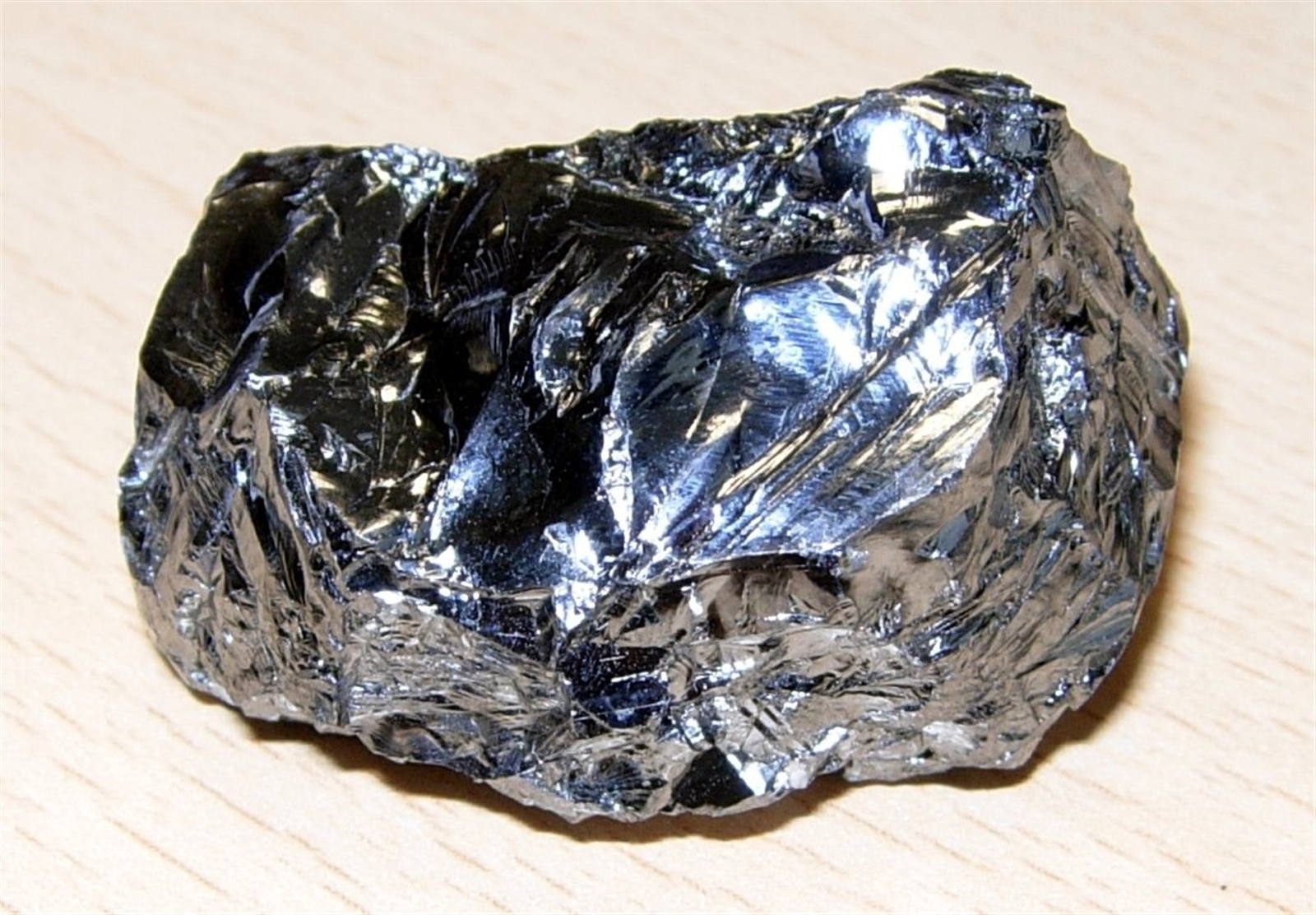
[Mercury and silicon. Left Image Credit: NASA / JPL; Right Image Credit: Wikipedia]
--- === ---
LUNAR CRUSTAL MAGNETIZATION INFERRED FROM CHARACTERISTICS OF LUNAR SWIRLS
I thought I knew a lot about the moon. But, as it turned out, he was not aware of the existence of “ lunar swirls ”. Moreover, I can not even imagine what is the official name of this phenomenon in Russian. On the Internet, there are "eddies", "twists", "curls", "albedo anomalies" and "diffuse structures". The latter, though less often, but in more serious sources, so I will use this term.
Discovered in the 1960s, these structures still represent a mystery. Outwardly, they look like bright stripes and spots, with a kind of periodic pattern:
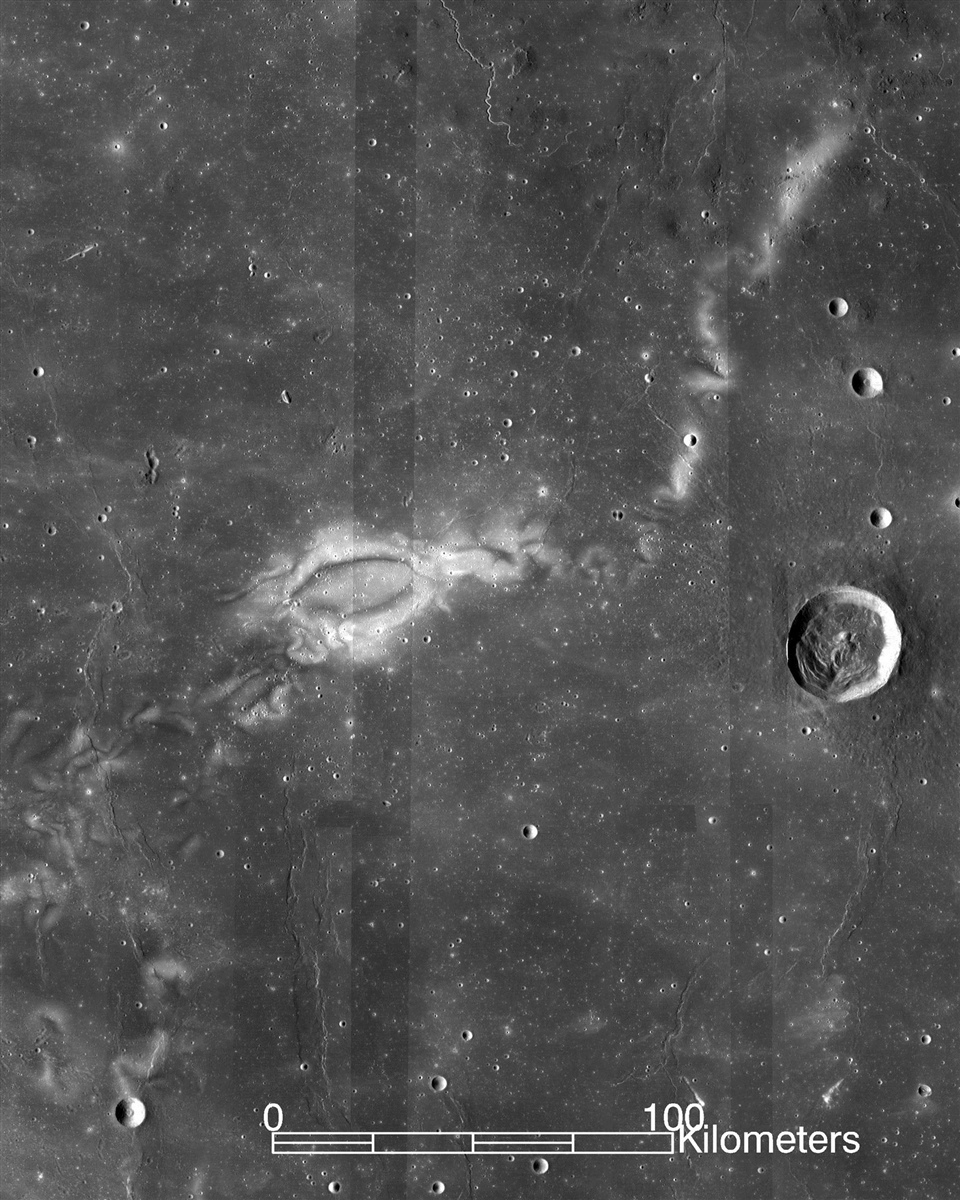

[Lunar diffuse structures. Left Image Credit: Wikipedia; Right Image Credit: NASA]
This pattern vividly reminded me of the pictures that appear on the electron-beam TV when the magnet is presented, if anyone remembers such a phenomenon. This similarity is reflected in one of the hypotheses explaining the diffusion structures. It is believed that under them in the lunar soil are natural permanent magnets. Say, a magnetized lava tube or the remains of an iron meteorite. With their magnetic field, they deflect energetic charged particles of the solar wind, not allowing them to bombard the surface - and therefore it remains bright. A kind of invisible protective dome over the terrain. By the way, these structures are really associated with magnetic anomalies.
The work itself is about estimating the parameters of a buried magnet, but I already had enough surprise.
--- === ---
HOW DIELECTRIC BREAKDOWN MAY WEATHER THE LUNAR REGOLITH
Not only meteorites plow the lunar surface. It turns out that the solar wind, especially on a moonlit night, makes a comparable contribution. How? The flow of energetic electrons. Which can fly into the night side of the Moon and charge regolith particles there to tensions of ~ 10 6 V / m. What leads to explosive electrical breakdown. The material in the breakdown channel evaporates, adding gas to the rarefied lunar atmosphere, and the speck of dust is destroyed or melted. Soil, as a result, slowly mixed. This works the better, the darker and colder the terrain (in warmth, the charge “flows down” with normal conductivity).
So, who knows, maybe the traces of astronauts will not be erased by dust from a meteorite fallen near, but by gradual evaporation from trillions of microscopic electrical breakdowns?

[Also electric discharge, but larger]
--- === ---
SPACECRAFT IMPACTS ON THE MOON: CHANG'E 1, APOLLO LM ASCENT STAGES
Electronic poster
Cosmonautics already has its own archeology. Considering the modern orbital images of the planets, people find vehicles there that had reached these celestial bodies decades earlier (see, for example, the magnificent story about Mars-3 ).
The author of this work specializes in the traces of falling lunar vehicles, collecting a whole collection of them. This year, four more were added to them: from the take-off steps of Apollo 12 and -14, the Chinese Chang'E 1, and, most recently, from the European SMART-1.
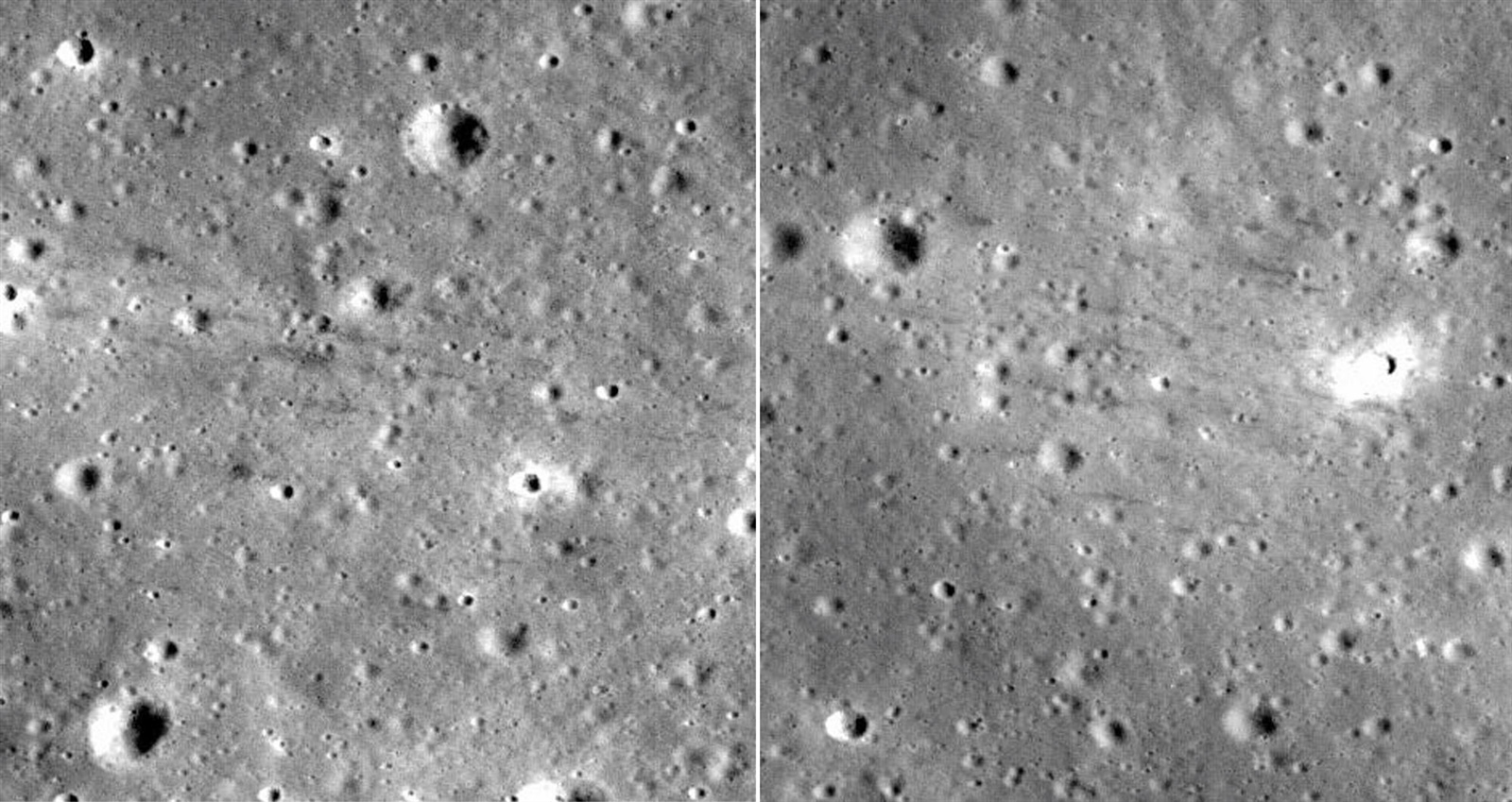
[Traces of the fall of the Apollo 12 take-off stage. Image Credit: NASA / Philip J. Stooke]
It was a little surprised (besides the topic itself) that many falls leave behind not craters at all, but streaks and stripes. Apparently, speeds of 1 km / s and below are not enough for the explosive destruction of the vehicle or the ground, and sliding contact simply leads to splitting debris at long distances along the direction of the orbit.
--- === ---
SIZE AND SOLAR INCIDENCE DISTRIBUTION OF SHADOWS ON THE MOON
It is hard to believe that the Moon, which has been investigated for more than half a century, has been photographed in the 30-centimeter resolution “photographed from the face and the back,” covered with 180 tons of human garbage , can even conceal something mysterious. Yes, and in such a banal, it would seem, things like shadows.
And yet.
The authors engaged in a simple and seemingly boring activity. They began to study the size of the lunar shadows. Statistics in its purest form. But not obvious. After all, shadow is a complicated thing. With the "sliding" morning fall of the rays on the characteristics of the relief depends extremely nontrivially.
And dug up. The density of shadows with sizes of 3-100 meters, firstly, does not depend on their size, and secondly, it does not have a clear explanation. So, there is something in the distribution of the lunar surface bumps on these scales, which we do not yet understand. People at the conference asked clever questions, compared something with the distribution of crater sizes, were surprised, but I will not undertake to retell it.
It would seem that the golemish statistics of black and white spots, but brought to mind - and now it turns out that on the long-studied Moon another mystery lies. Somewhere in deep shadow ...

[Picture from work. Image Credit: Oded Aharonson, Paul O. Hayne, Norbert Schorghofer]
--- === ---
PENITENTES AT TARTARUS DORSA, PLUTO
Calgaspor (they are also penitentes, penitentes ) are beautiful and unusual fields of snow-ice needles:

[Calgaspora. Image Credit: Wikipedia]

[Calgaspora. Image Credit: Wikipedia]
Until now, they were known only on Earth. But, according to the latest data, it seems that they are also found on Pluto.
Of course, nobody saw them near them. But the authors of the paper claim that these long strips in the photograph “are well described by theoretical models of calgaspores, and their interval, orientation and growth rates are in good agreement with the observations of methane ices of New Horizons on Pluto”.

[Pluto, region of Tartarus Dorsa. Image Credit: NASA / JHUAPL / SWRI]
And yes, most likely Plutonian calgaspores consist of methane (CH 4 ) ice.
--- === ---
BISMUTH TELLURIDES AND SULFIDE MIXTURES AND THEIR RELATION TO METAL FROST ON VENUS
On the radar images of the Venusian hills, something very like snow is visible. But, of course, at 500 degrees Celsius, it should be something else. Something with high reflectivity and high dielectric constant. Perhaps almost metallic nature. What exactly?
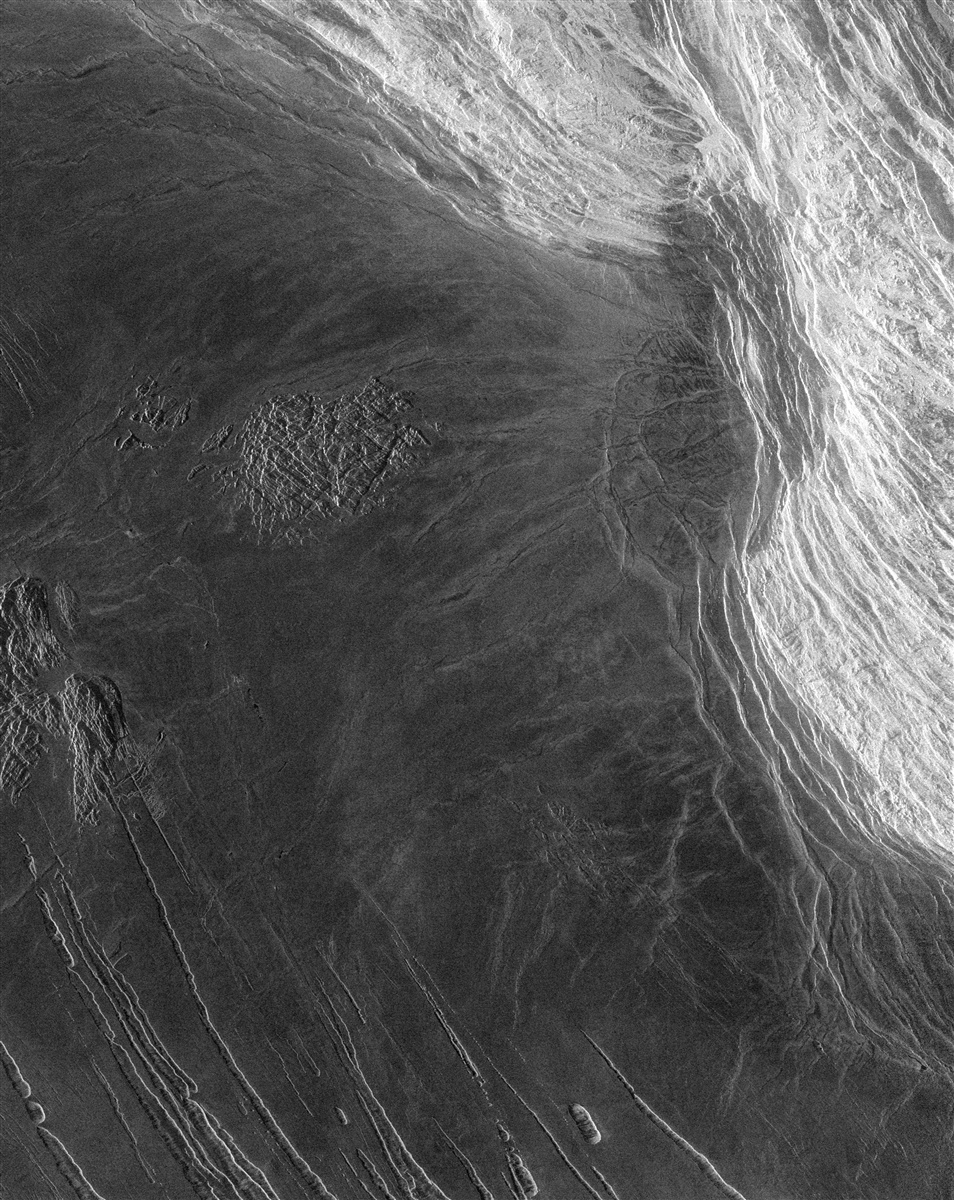
["Snow" in the mountains of Maxwell on Venus. Image Credit: NASA / Magellan]
The authors suggested that these are tellurides or mixed bismuth sulfides ( Bi 2 Te 3 , Bi 2 Te 2 S ). Recreating Venusian in vitro, they look at how these substances sublimate and interact with the atmosphere. Trying, in particular, to understand whether they, like terrestrial snow, settle in the mountains of Venus in the local 300-degree "frost".
The conclusions are ambiguous, and in general the work did not seem to me particularly convincing. Assumptions and alternative explanations are visible even to a non-specialist. But the imagination of this "semiconductor snow" spurs, and therefore leave the list.
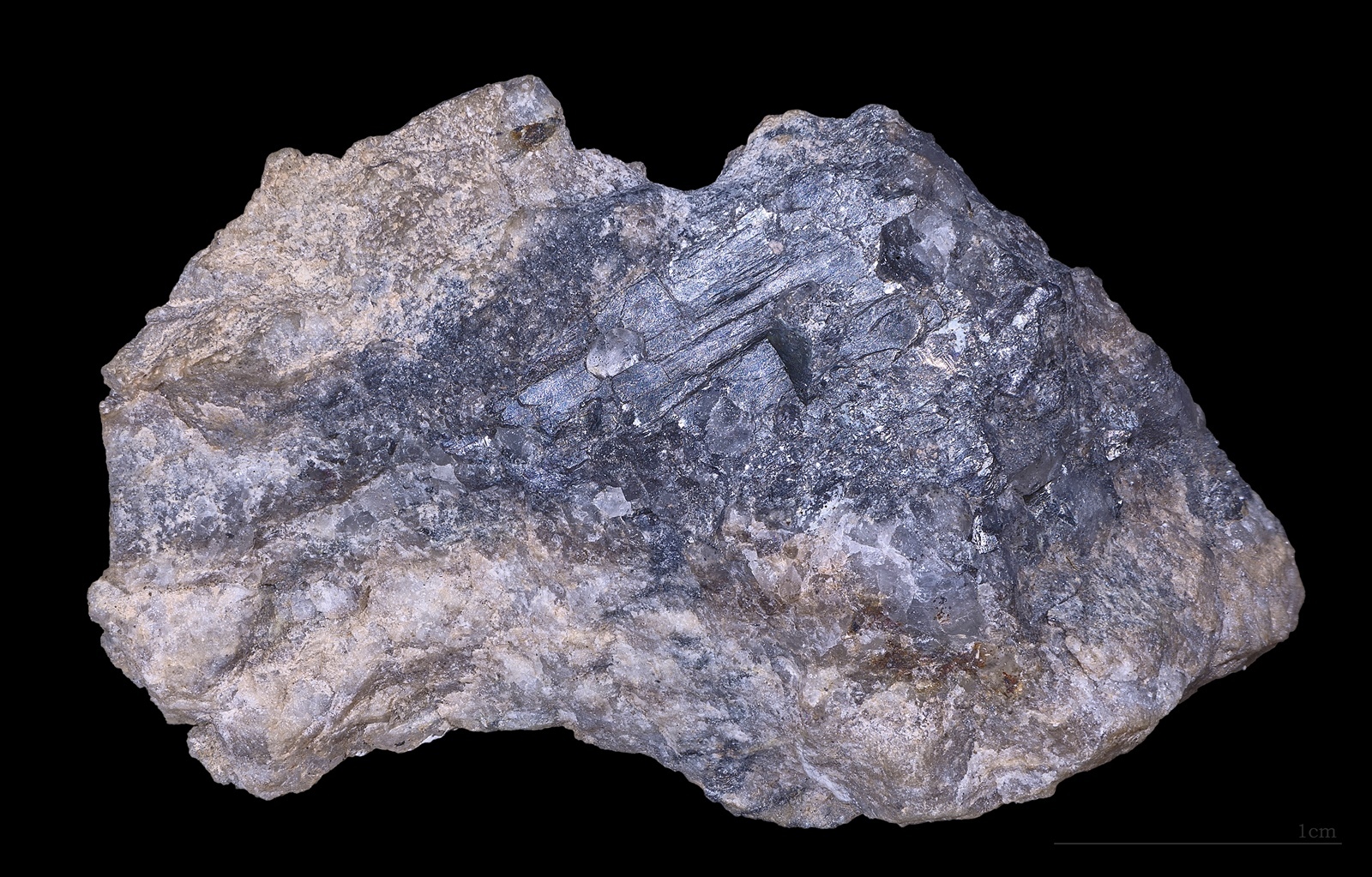
[Bismuth sulfide telluride, also known as tetradimite. Image Credit: Wikipedia]
--- === ---
THE BIOPAUSE PROJECT: BALLOON EXPERIMENTS FOR SAMPLING STRATOSPHERIC BIOAEROSOL
Those who read Kraytonov's "Strain Andromeda", immediately appreciate the beauty of these studies. The idea is the same: to get closer to space, “scoop up” life from there and bring it down for study. In order to understand how far earthly life extends into the stratosphere, and what it looks like there.
Of course, such studies have been conducted for a long time. So, in the USSR, in 1976, microorganisms were brought from altitudes of 48-77 kilometers. But the Japanese Aerospace Agency (JAXA) is so remarkable that it constantly inventing interesting projects for fairly reasonable money.
The fact is that usually such studies rely on the cultivation of the extracted samples in the laboratory. We sow, grow, analyze what has grown. The problem, however, is that over 99% of terrestrial microorganisms are non-cultured . They do not know how to grow in the laboratory. Accordingly, 99% of the species diversity of this approach from the "catch" is lost.
The Japanese bypassed this difficulty by simply examining all the extracted samples with a fluorescence and scanning electron microscope. And although their balloon brought germs from relatively “modest” heights of 13-27 km, this is the first assessment of the density of all (including uncultivated) microorganisms in the stratosphere.
Unfortunately, during the flight they managed to lose the test (for negative control) camera. For what reason do they plan to repeat the launch in June 2017 in combination, if I heard correctly, with the genetic analysis of the microorganisms obtained.
--- === ---
SURVIVABILITY OF RNA AND PROTEIN MONOMERS AGAINST EFFECTS OF SHOCK PRESSURES
Suppose a meteorite with terrestrial DNA crashes into another planet. Explosion, pressure surge, instant warm-up. Will organics survive this adventure? To find out, the authors fired artificial "meteorites" with an admixture of proteins and ribonucleic acids at targets and measured how much organic matter would survive after the impact. It turns out not very much:
Does this mean that panspermia does not work? Certainly not. You can think of a lot more gentle ways of delivering organic meteorites. But, in any case, a direct, airless “head-on” impact on a body the size of Mars seems to be fatal even for relatively simple organic molecules.
--- === ---
PULMONARY INFLAMMATORY RESPONSES TO ACUTE METEORITE DUST EXPOSURES - IMPLICATIONS FOR HUMAN SPACE EXPLORATION
This topic is not new. I read somewhere in the 95th year that moon dust is very harmful to the lungs and causes strong silicosis in laboratory rats.
In this paper, we investigated the inflammatory stress response ("inflammatory stress response") of human lung tissue to lunar, Martian dust, from Vesta, and terrestrial. The first three are extracted from meteorites from the corresponding bodies, the last - from earthly basalts.
The observations are disappointing. All types of dust have a very noticeable and negative effect on the lungs.But the most vicious dust is the Martian dust, it is comparable in effect to the earth’s mining sludge, from which people are seriously ill. Behind her comes the moon dust. The ground gravel basalts showed the least harm, although, of course, they are also not honey.

[Picture from the work described. Stress response of the lung tissue to different types of dust. Image Credit: AD Harrington, FM McCubbin, J. Kaur, A. Smirnov, K. Galdanes, MAA Schoonen, LC Chen, SE Tsirka, T. Gordon / NASA Johnson Space Center; Dept. of New York University School of Medicine; Dept. of Geosciences, Stony Brook University; Geology Dept., Lone Star College; Environmental Sciences Dept., Brookhaven National Laboratory; Pharmacological Sciences, Stony Brook University]
Findings? First, if people ever set foot on Mars, they will have to defend themselves from dust seriously (so my stack of sheets of marked inaccuracies and comments on the Martian was replenished with one more item). Secondly, we sometimes sometimes underestimate the role of dust in planned long-term expeditions. Moon dust, for example, has a terrible abrasive ability, leading to the rapid killing of moving mechanisms and rubbing surfaces. Who is curious, I advise you to read at least the last paragraph on page five of this document .
--- === ---
CLIMATE OPTIMUM ON MARS INITIATED BY ATMOSPHERIC COLLAPSE
Today’s Mars is dry and superbly sterilized. But it is reliably known that at least one episode of warming happened there a long time ago, with a warm dense atmosphere and liquid water, from which the river beds remained. How long, how long and what caused this favorable climate? This is where the various hypotheses begin.
One of them was put forward in the work in question. Quite funny, like "the fire was caused by a fire engine that arrived on a false call." There it is argued that the warming period was a response to the first collapse of the atmosphere. Which caused the release of enormous quantities of methane, previously stored in the soil in the form of methane clathrates. The oxidation and photolysis products of this methane caused a strong greenhouse effect and warming. Is it all really, I do not presume to judge. But the hypothesis is interesting.
--- === ---
DRIVEN BY EXCESS? CLIMATIC IMPLICATIONS OF NEW GLOBAL MAPPING OF NEAR-SURFACE HYDROGEN ON MARS
Dealing with complex findings that I mostly did not make out. I remember a simpler initial premise.
The authors constructed an updated map of the hydrogen content in the surface layers of Mars, according to data from the Mars Odyssey neutron spectrometer. And it turned out that the ice content in the first decimeters of the surface of Mars is at least a few percent even at the equator, reaching> 90% closer to the poles.
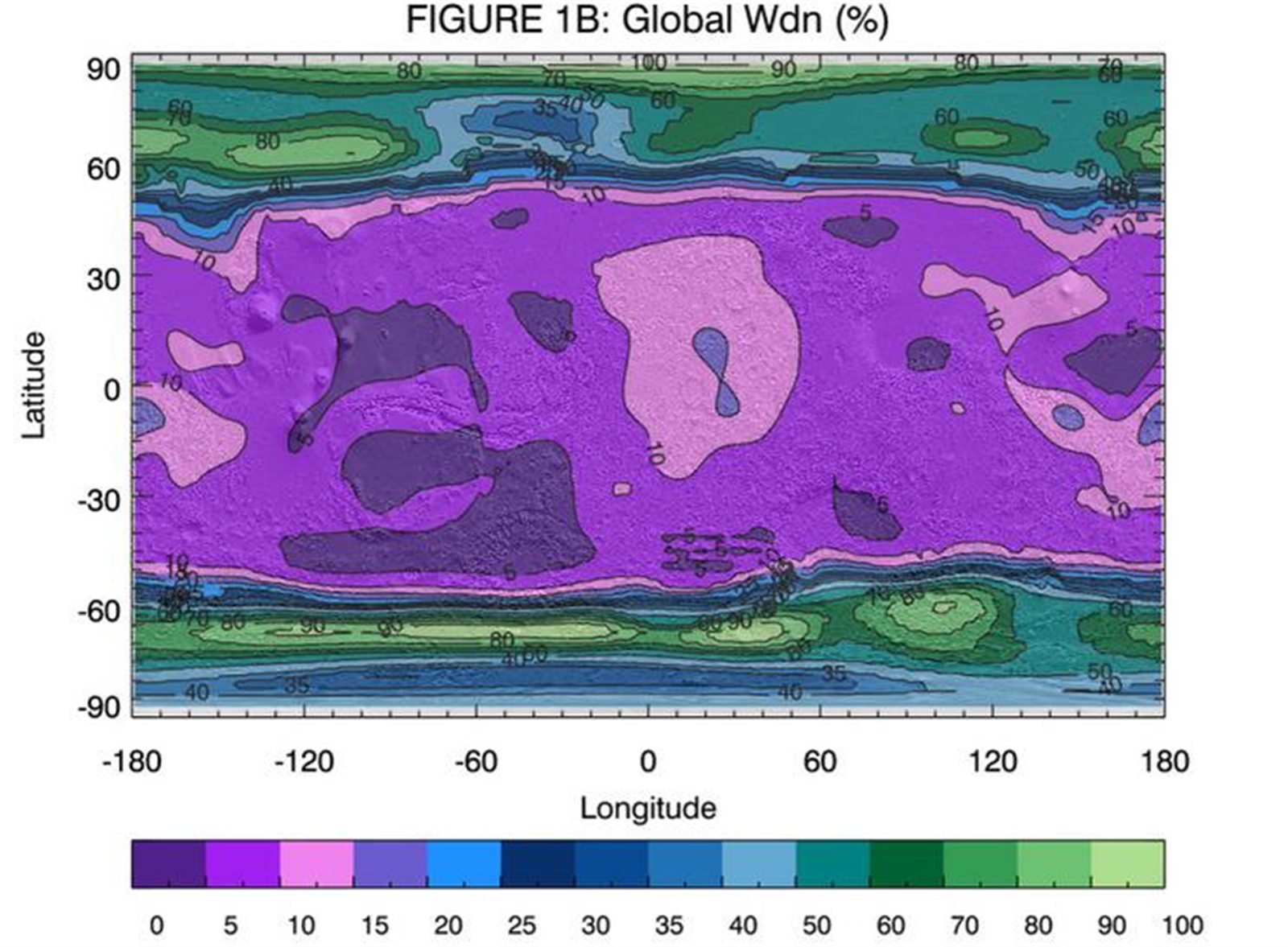
[Map of the hydrogen content (in terms of water) in the first decimeters of the surface of Mars. Image Credit: AV Pathare; WC Feldman; TH Prettyman; S. Maurice / Planetary Science Institute, Tucson, AZ; IRAP, Université Paul Sabatier, Toulouse, France]
Of course, ice on Mars was found a long time ago. But it seems that he is there several times even more than previously thought.
--- === ---
CAN MARS BE TERRAFORMED?
The short answer is no.
A detailed answer: in principle, it is possible to come up with much. But the most straightforward project is unlikely to work. Its essence is that, by evaporating enough carbon dioxide CO 2 from the Martian polar caps, you can (would) enhance the greenhouse effect to such an extent that the climate on Mars becomes warm and self-sustaining.
However, having conducted an audit of CO 2 reserves on Mars using the most recent data, the authors came to the same conclusion that I received more crude methods in 2006. Namely, carbon dioxide reserves on Mars are not enough to implement this scenario; and even the evaporation of all polar caps will warm the planet only by about 10 degrees, which is not enough to go into a self-sustaining warm regime.
--- === ---
EFFICIENCY OF ATMOSPHERIC EROSION BY IMPACTS: ENERGY CONSIDERATIONS AND APPLICATIONS
First, there is such a thing as Shuvalov’s parameters. These are formulas linking the efficiency of "scattering" the atmosphere of an asteroid falling on the planet with the parameters of the asteroid and the atmosphere:

Secondly, this efficiency has a maximum. A meteorite too large or too fast has a worse efficiency of "stripping" of the atmosphere than its smaller counterpart:
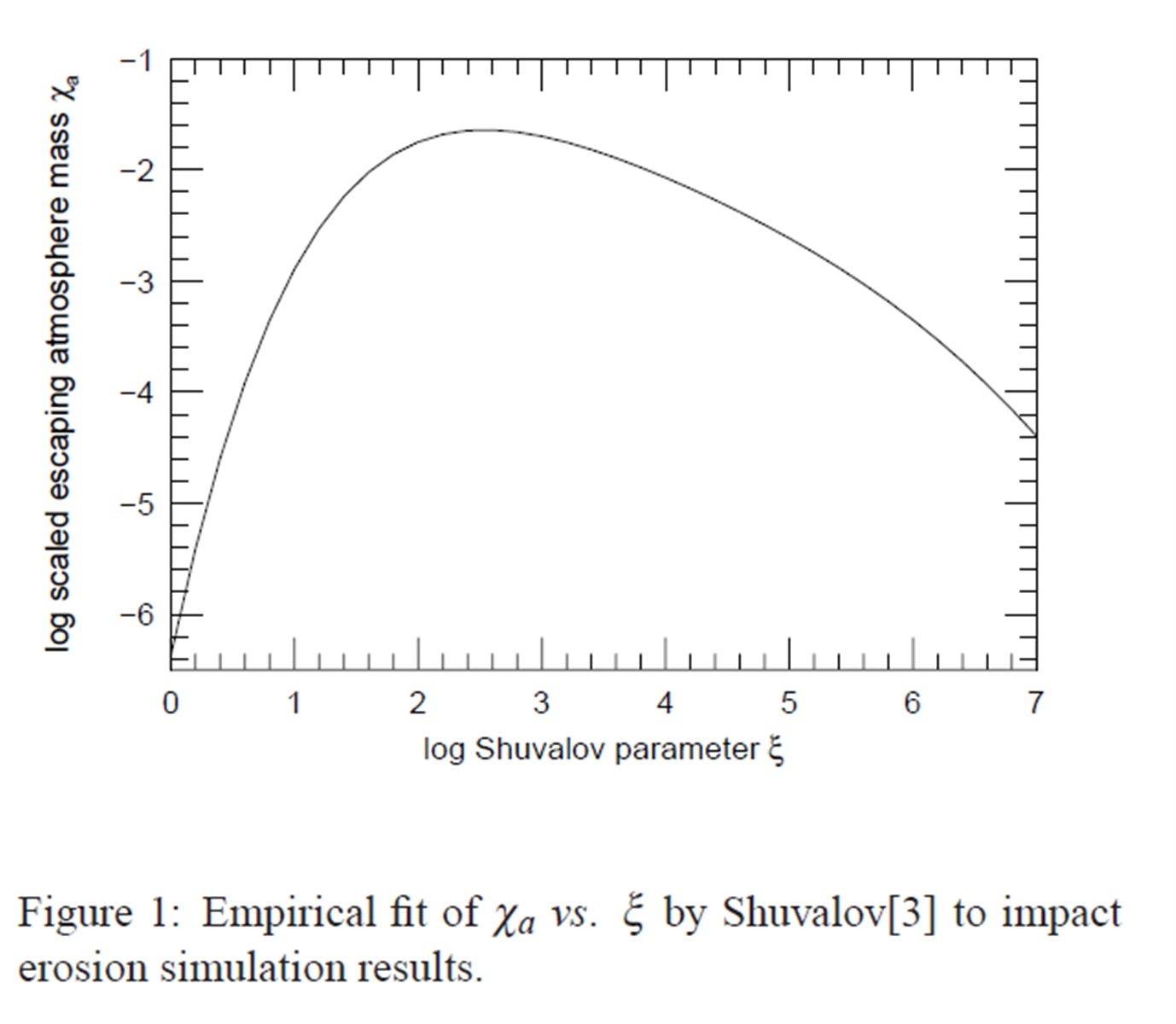
[The efficiency of atmospheric ablation by an asteroid as a function of the Shuvalov parameter ξ. Image Credit: Shuvalov, V., 2009. Meteorit. Planet. Sci. 44, 1095-1105.]
Third, by choosing the asteroids of maximum efficiency, one can calculate how much they will need to “disrupt” most of the atmosphere of Venus. The answer is a lot. Unreal many. We are talking about the masses in (0.5-9)% of the mass of the moon. The upper bound of this estimate exceeds the mass of the asteroid belt. It can be roughly estimated that the kinetic energy required to reject such a breakthrough of asteroids is at least ~ 10 27 Joules, which is a million times higher than the annual energy budget of mankind.
Thus, the projects of terraforming of Venus by “blowing out” of its atmosphere remain, at best, science fiction.
--- === ---
OCEANUS: Planetary Science Summer School: Uranus Orbiter Concept Study from the 2016 NASA / JPL
Electronic Poster
Pros: NASA finally decided to consider the concept of a serious expedition to Uranus. With an exit into an orbit and a landing probe.
Cons: everything is very preliminary. Students do this. It is not known what class the mission will be, and this radically determines the budget for the financial, mass, and general layout of the station. Therefore, several very different concepts are being worked out simultaneously in parallel. The launch, if it takes place, is not earlier than the year 2030, with arrival to Uranus in the 2040s. In general, if you manage to live and get lucky with health, then perhaps it will be interesting to me.
Update: at the NASO briefing, however, broader work on this topic was announced (picture from the video briefing, not from the title work), so perhaps everything will be somewhat more optimistic:

--- === ---
A GEOPHYSICAL PLANET DEFINITION
From a geophysical point of view, Pluto and all rather large bodies like Titan, Europe or Ganymede are full-fledged planets. When describing them, most of the features inherent in "real" planets are mentioned (equilibrium spherical shape, differentiation, tectonic activity, atmosphere, features of surface renewal and formation processes, thermal history). In the textbooks of planetology, Pluto or Ganymede is more natural and more logical described in the same section with Mars and Venus, rather than with small asteroids. The language used to describe Pluto is much closer to the "Martian" than to the "cometary . " Finally, the authors cite more than 40 scientific works from refereed journals, where Titan and Europe are referred to as planets.
And all this does not depend on the fact whether "the body cleared its orbit".
Therefore, the authors of this paper propose to “stop the disgrace” with dwarf planets and, without waiting for permits (which are not required) from the International Astronomical Union, to begin, finally, just to call all these bodies planets.
--- === ---
Planetary Topography from Laser Altimetry A
lecture about laser altimeters around other planets. Educational and interesting. But in English, of course, nothing can be done. The first part of the video - the distribution of elephants and congratulations; for the lecture you need to rewind to the 16th minute.
--- === ---
NASA Headquarters Briefing
Another video. NASA executives report on progress, budget and plans for the future. Minutes from the 51st public questions begin, where, among other things, NASA seriously gets to reduce the cost of research on Earth, climate, and human impact on the latter.
--- === ---
This is all. Thanks for attention!

After reading a couple of hundred reports and poster presentations, here I want to share a summary of the works that seemed interesting.
Disclaimer (disclaimer). I am a physicist by education, but still not a specialist in planetology. My selection of material is certainly subjective and incomplete. My interpretation of the work may be erroneous. If for you such things as finances, work, or professional reputation depend on its accuracy, then it is better to get in touch with the authors and recheck everything with them directly. Their contacts are listed in the abstracts of works under the links. Amendments from readers, of course, welcome.
So let's go!
')
TRANSIENT BROAD SPECULAR REFLECTIONS FROM TITAN'S NORTH POLE
The brilliance of the Sun in the lakes of Titan has been photographed for quite some time:

[Sun glare on Titan. Image Credit: NASA]
However, more recently, similar reflections have begun to be noticed where there are no lakes. Moreover, they are impermanent. Today sparkles, in the next span with a very similar geometry - no longer. What's the matter?
To explain the hypothesis of "wet asphalt". Imagine that a methane rain has passed over a slightly rough terrain. "Asphalt" is wet and shiny. To the next Cassini passage above the terrain, it dried out and no reflections were observed:

--- === ---
METHANE, ETHANE AND NITROGEN LIQUID STABILITY ON TITAN
Continue about the hydrosphere of Titan. Developed with seas and rivers. True, the prefix "hydro" is not quite appropriate here, because there is no water in those seas, but they are filled with liquid methane (CH 4 ), ethane (C 2 H 6 ) and nitrogen (N 2 ). It is not very clear only in what proportions and how these substances generally interact in the conditions of Titan. What and work. Quite a lab.
The authors took these three gases, cooled them to cryogenic temperatures, and began to watch how they mix and when they freeze, depending on concentrations and pressures. And they found things in the light of which Titan's hydrosphere looks like a much more complex system compared to the Earth’s oceans. However, if you have three “waters” and three different ice instead of one, then something like this should have been expected.
Methane-ethane mixture freezes with a more severe frost than each of the gases separately. That is, these gases work as mutual antifreeze.
When this mixture freezes, the methane ice floats to the surface, while the ethane sinking and sinks to the bottom. Which is formed first - depends on the initial concentration.

[Photo of an experimental camera from work. On the left - ethane ice at the bottom of the liquid mixture. On the right - methane on its surface. Image Credit: J. Hanley, L. Pearce, G. Thompson, W. Grundy, H. Roe, G. Lindberg, S. Dustrud, D. Trilling, S. Tegler / Lowell Observatory, Flagstaff, AZ; Northern Arizona University, Flagstaff, AZ; University of Texas, Austin, TX.]
Further, the ingress of nitrogen into the mixture (just from the atmosphere) can raise the melting point of the mixture, and, accordingly, lead to its unexpected freezing. By the way, in another work it is shown that nitrogen is well dissolved in methane - but it is bad in ethane. Thus, the evaporation of a part of methane from a liquid can cause a sudden “boiling up” of the sea. Some kind of cryogenic champagne with nitrogen bubbles.
Finally, the most interesting. At pressures of more than 2.5 atmospheres (corresponding to depths of more than ~ 100 meters on Titanium), the methane-ethano-nitrogen mixture is divided into two liquid phases. The report was a terrific video, but here you’ll have to limit it to a not very good picture:

[Image Credit: J. Hanley, L. Pearce, G. Thompson, W. Grundy, H. Roe, G. Lindberg, S. Dustrud, D. Trilling, S. Tegler / Lowell Observatory, Flagstaff, AZ; Northern Arizona University, Flagstaff, AZ; University of Texas, Austin, TX.]
Top - gas. Below it is the first liquid phase, rich in ethane. Under it - the second, rich in nitrogen. And on the "ceiling" of the first phase there is a tiny hint of a drop. This is the second phase condensate. Which is the real drops, like oil in water, flows through the first light into the second.
Imagine a double-layered sea? So do I.
After the report, I thought about this. The terrestrial oil industry has long been engaged in cryogenic separation of associated gases. Of which the very first - just methane with ethane. Well, nitrogen and the atmosphere is full. So, perhaps, people are already familiar with all these interesting effects in oil refining. It is difficult not to pay attention to the suddenly frozen (from nitrogen) pipeline. But if this is so, then surely all these studies are deeply closed corporate secrets ...
--- === ---
CLASSIFICATION OF LABYRINTH TERRAINS ON TITAN
The labyrinths of Titan are plateaus, cut by a complex system of valleys and ridges, visually resembling the bark of a tree:

[Image Credit: NASA / JPL]
Their nature is not quite clear. At first glance, they look like river beds - and we know that there are rivers on Titan. But, looking more closely, you can see that some of these “labyrinths” are closed. They do not flow from anywhere and nowhere.
So at least part of the labyrinths are not a river bed? The authors took up morphological analysis and concluded that some of these formations are supposedly ... karst ! But what exactly causes them - whether the material is dissolved by underground flows, flushing or evaporation - remains unknown.
Do not labyrinth plains on Titan consist of such gullets?

--- === ---
TOPOGRAPHIC ASSESSMENT OF HOLLOWS ON MERCURY: DISTINGUISHING AMONG FORMATION HYPOTHESES
Since we are talking about karst , it makes sense to transfer to Mercury. Mysterious pits ("hollows") on it, too, have not been properly explained yet. But one hypothesis says that these are ... karst too. Formed by the evaporation of some volatile substance under a layer of dust and regolith.
So they look like this:


[Pits on Mercury. Yes, in these spots one should try to see the pits, not the protrusions, and in the rounded mounds - concave craters. Sometimes the rotated picture helps, so I added this. Image Credit: NASA]
We do not know what this material is. And I don't even know if the hypothesis is true. In this paper, I just liked the pictures. Good, beautiful photos of "pits", collected by the authors for the purpose of their classification and submitted to the public. The numbers I wrote down. And may the authors forgive me, one laid out, slightly with the photo shop to raise the contrast. In my defense, I note that the pictures on the presentation also looked much better than the originals from the site MESSENGER.

[Image Credit: NASA / JPL]
--- === ---
OXYGEN DEPLETION ON THE SURFACE OF MERCURY: EVIDENCE OF SILICON SMELTING?
Having spent 4 years in orbit around Mercury, the MESSENGER apparatus was able to measure the content of the main mineral forming elements (O, Si, Ti, Al, Cr, Fe, Mn, Mg, Ca, Na, K, S, Cl) in the surface of the planet.
True, the device sees only the concentration of atoms, and not the chemical bonds between them. To estimate the mineral composition, all metal elements are usually assumed to be fully oxidized. That is, silicon, for example, is present as SiO 2 , aluminum as Al 2 O 3, and the like. From the resulting oxides, then, as a constructor, minerals make up (for example, calcium silicate Ca 2 SiO 4 is 2 * CaO + SiO 2 ).
Everything is good, but for Mercury this is not working. The balance of oxygen does not converge. It is not enough to oxidize everything that is oxidized, retaining the measured ratio of oxygen to silicon O / Si = 1.4 ± 0.03 (and even less, as stated in the work).
In an attempt to explain this inconsistency, a hypothesis was advanced: in the depths of Mercury, a kind of “metallurgical smelting” of pure silicon from quartz and graphite occurs, which, as we strongly suspect, makes up a few percent of the planet's crust.
If this is true, then 12.6–17.9% (by weight) of the surface of the northern hemisphere of Mercury should be formed of metallic silicon or its alloy with iron.
What is interesting? Well, firstly, non-oxidized silicon as a rock-forming substance is unusual. Secondly, on all other stony bodies (Moon, Earth, Mars) oxygen is in excess and everything that can in principle be oxidized by it, oxidized for a long time. Why is it suddenly not so well-done by the sun of Mercury? Riddle.


[Mercury and silicon. Left Image Credit: NASA / JPL; Right Image Credit: Wikipedia]
--- === ---
LUNAR CRUSTAL MAGNETIZATION INFERRED FROM CHARACTERISTICS OF LUNAR SWIRLS
I thought I knew a lot about the moon. But, as it turned out, he was not aware of the existence of “ lunar swirls ”. Moreover, I can not even imagine what is the official name of this phenomenon in Russian. On the Internet, there are "eddies", "twists", "curls", "albedo anomalies" and "diffuse structures". The latter, though less often, but in more serious sources, so I will use this term.
Discovered in the 1960s, these structures still represent a mystery. Outwardly, they look like bright stripes and spots, with a kind of periodic pattern:


[Lunar diffuse structures. Left Image Credit: Wikipedia; Right Image Credit: NASA]
This pattern vividly reminded me of the pictures that appear on the electron-beam TV when the magnet is presented, if anyone remembers such a phenomenon. This similarity is reflected in one of the hypotheses explaining the diffusion structures. It is believed that under them in the lunar soil are natural permanent magnets. Say, a magnetized lava tube or the remains of an iron meteorite. With their magnetic field, they deflect energetic charged particles of the solar wind, not allowing them to bombard the surface - and therefore it remains bright. A kind of invisible protective dome over the terrain. By the way, these structures are really associated with magnetic anomalies.
The work itself is about estimating the parameters of a buried magnet, but I already had enough surprise.
--- === ---
HOW DIELECTRIC BREAKDOWN MAY WEATHER THE LUNAR REGOLITH
Not only meteorites plow the lunar surface. It turns out that the solar wind, especially on a moonlit night, makes a comparable contribution. How? The flow of energetic electrons. Which can fly into the night side of the Moon and charge regolith particles there to tensions of ~ 10 6 V / m. What leads to explosive electrical breakdown. The material in the breakdown channel evaporates, adding gas to the rarefied lunar atmosphere, and the speck of dust is destroyed or melted. Soil, as a result, slowly mixed. This works the better, the darker and colder the terrain (in warmth, the charge “flows down” with normal conductivity).
So, who knows, maybe the traces of astronauts will not be erased by dust from a meteorite fallen near, but by gradual evaporation from trillions of microscopic electrical breakdowns?

[Also electric discharge, but larger]
--- === ---
SPACECRAFT IMPACTS ON THE MOON: CHANG'E 1, APOLLO LM ASCENT STAGES
Electronic poster
Cosmonautics already has its own archeology. Considering the modern orbital images of the planets, people find vehicles there that had reached these celestial bodies decades earlier (see, for example, the magnificent story about Mars-3 ).
The author of this work specializes in the traces of falling lunar vehicles, collecting a whole collection of them. This year, four more were added to them: from the take-off steps of Apollo 12 and -14, the Chinese Chang'E 1, and, most recently, from the European SMART-1.

[Traces of the fall of the Apollo 12 take-off stage. Image Credit: NASA / Philip J. Stooke]
It was a little surprised (besides the topic itself) that many falls leave behind not craters at all, but streaks and stripes. Apparently, speeds of 1 km / s and below are not enough for the explosive destruction of the vehicle or the ground, and sliding contact simply leads to splitting debris at long distances along the direction of the orbit.
--- === ---
SIZE AND SOLAR INCIDENCE DISTRIBUTION OF SHADOWS ON THE MOON
It is hard to believe that the Moon, which has been investigated for more than half a century, has been photographed in the 30-centimeter resolution “photographed from the face and the back,” covered with 180 tons of human garbage , can even conceal something mysterious. Yes, and in such a banal, it would seem, things like shadows.
And yet.
The authors engaged in a simple and seemingly boring activity. They began to study the size of the lunar shadows. Statistics in its purest form. But not obvious. After all, shadow is a complicated thing. With the "sliding" morning fall of the rays on the characteristics of the relief depends extremely nontrivially.
And dug up. The density of shadows with sizes of 3-100 meters, firstly, does not depend on their size, and secondly, it does not have a clear explanation. So, there is something in the distribution of the lunar surface bumps on these scales, which we do not yet understand. People at the conference asked clever questions, compared something with the distribution of crater sizes, were surprised, but I will not undertake to retell it.
It would seem that the golemish statistics of black and white spots, but brought to mind - and now it turns out that on the long-studied Moon another mystery lies. Somewhere in deep shadow ...

[Picture from work. Image Credit: Oded Aharonson, Paul O. Hayne, Norbert Schorghofer]
--- === ---
PENITENTES AT TARTARUS DORSA, PLUTO
Calgaspor (they are also penitentes, penitentes ) are beautiful and unusual fields of snow-ice needles:

[Calgaspora. Image Credit: Wikipedia]

[Calgaspora. Image Credit: Wikipedia]
Until now, they were known only on Earth. But, according to the latest data, it seems that they are also found on Pluto.
Of course, nobody saw them near them. But the authors of the paper claim that these long strips in the photograph “are well described by theoretical models of calgaspores, and their interval, orientation and growth rates are in good agreement with the observations of methane ices of New Horizons on Pluto”.

[Pluto, region of Tartarus Dorsa. Image Credit: NASA / JHUAPL / SWRI]
And yes, most likely Plutonian calgaspores consist of methane (CH 4 ) ice.
--- === ---
BISMUTH TELLURIDES AND SULFIDE MIXTURES AND THEIR RELATION TO METAL FROST ON VENUS
On the radar images of the Venusian hills, something very like snow is visible. But, of course, at 500 degrees Celsius, it should be something else. Something with high reflectivity and high dielectric constant. Perhaps almost metallic nature. What exactly?

["Snow" in the mountains of Maxwell on Venus. Image Credit: NASA / Magellan]
The authors suggested that these are tellurides or mixed bismuth sulfides ( Bi 2 Te 3 , Bi 2 Te 2 S ). Recreating Venusian in vitro, they look at how these substances sublimate and interact with the atmosphere. Trying, in particular, to understand whether they, like terrestrial snow, settle in the mountains of Venus in the local 300-degree "frost".
The conclusions are ambiguous, and in general the work did not seem to me particularly convincing. Assumptions and alternative explanations are visible even to a non-specialist. But the imagination of this "semiconductor snow" spurs, and therefore leave the list.

[Bismuth sulfide telluride, also known as tetradimite. Image Credit: Wikipedia]
--- === ---
THE BIOPAUSE PROJECT: BALLOON EXPERIMENTS FOR SAMPLING STRATOSPHERIC BIOAEROSOL
Those who read Kraytonov's "Strain Andromeda", immediately appreciate the beauty of these studies. The idea is the same: to get closer to space, “scoop up” life from there and bring it down for study. In order to understand how far earthly life extends into the stratosphere, and what it looks like there.
Of course, such studies have been conducted for a long time. So, in the USSR, in 1976, microorganisms were brought from altitudes of 48-77 kilometers. But the Japanese Aerospace Agency (JAXA) is so remarkable that it constantly inventing interesting projects for fairly reasonable money.
The fact is that usually such studies rely on the cultivation of the extracted samples in the laboratory. We sow, grow, analyze what has grown. The problem, however, is that over 99% of terrestrial microorganisms are non-cultured . They do not know how to grow in the laboratory. Accordingly, 99% of the species diversity of this approach from the "catch" is lost.
The Japanese bypassed this difficulty by simply examining all the extracted samples with a fluorescence and scanning electron microscope. And although their balloon brought germs from relatively “modest” heights of 13-27 km, this is the first assessment of the density of all (including uncultivated) microorganisms in the stratosphere.
Unfortunately, during the flight they managed to lose the test (for negative control) camera. For what reason do they plan to repeat the launch in June 2017 in combination, if I heard correctly, with the genetic analysis of the microorganisms obtained.
--- === ---
SURVIVABILITY OF RNA AND PROTEIN MONOMERS AGAINST EFFECTS OF SHOCK PRESSURES
Suppose a meteorite with terrestrial DNA crashes into another planet. Explosion, pressure surge, instant warm-up. Will organics survive this adventure? To find out, the authors fired artificial "meteorites" with an admixture of proteins and ribonucleic acids at targets and measured how much organic matter would survive after the impact. It turns out not very much:
Impact pressure - (corresponding to it speed) -% safety:
10.5 GPa - (~ 2.2 km / s) - 4.3%
28 GPa - (~ 4 km / s) - 0.7%
40 GPA - (~ 6 km / s) - 0%
Does this mean that panspermia does not work? Certainly not. You can think of a lot more gentle ways of delivering organic meteorites. But, in any case, a direct, airless “head-on” impact on a body the size of Mars seems to be fatal even for relatively simple organic molecules.
--- === ---
PULMONARY INFLAMMATORY RESPONSES TO ACUTE METEORITE DUST EXPOSURES - IMPLICATIONS FOR HUMAN SPACE EXPLORATION
This topic is not new. I read somewhere in the 95th year that moon dust is very harmful to the lungs and causes strong silicosis in laboratory rats.
In this paper, we investigated the inflammatory stress response ("inflammatory stress response") of human lung tissue to lunar, Martian dust, from Vesta, and terrestrial. The first three are extracted from meteorites from the corresponding bodies, the last - from earthly basalts.
The observations are disappointing. All types of dust have a very noticeable and negative effect on the lungs.But the most vicious dust is the Martian dust, it is comparable in effect to the earth’s mining sludge, from which people are seriously ill. Behind her comes the moon dust. The ground gravel basalts showed the least harm, although, of course, they are also not honey.

[Picture from the work described. Stress response of the lung tissue to different types of dust. Image Credit: AD Harrington, FM McCubbin, J. Kaur, A. Smirnov, K. Galdanes, MAA Schoonen, LC Chen, SE Tsirka, T. Gordon / NASA Johnson Space Center; Dept. of New York University School of Medicine; Dept. of Geosciences, Stony Brook University; Geology Dept., Lone Star College; Environmental Sciences Dept., Brookhaven National Laboratory; Pharmacological Sciences, Stony Brook University]
Findings? First, if people ever set foot on Mars, they will have to defend themselves from dust seriously (so my stack of sheets of marked inaccuracies and comments on the Martian was replenished with one more item). Secondly, we sometimes sometimes underestimate the role of dust in planned long-term expeditions. Moon dust, for example, has a terrible abrasive ability, leading to the rapid killing of moving mechanisms and rubbing surfaces. Who is curious, I advise you to read at least the last paragraph on page five of this document .
--- === ---
CLIMATE OPTIMUM ON MARS INITIATED BY ATMOSPHERIC COLLAPSE
Today’s Mars is dry and superbly sterilized. But it is reliably known that at least one episode of warming happened there a long time ago, with a warm dense atmosphere and liquid water, from which the river beds remained. How long, how long and what caused this favorable climate? This is where the various hypotheses begin.
One of them was put forward in the work in question. Quite funny, like "the fire was caused by a fire engine that arrived on a false call." There it is argued that the warming period was a response to the first collapse of the atmosphere. Which caused the release of enormous quantities of methane, previously stored in the soil in the form of methane clathrates. The oxidation and photolysis products of this methane caused a strong greenhouse effect and warming. Is it all really, I do not presume to judge. But the hypothesis is interesting.
--- === ---
DRIVEN BY EXCESS? CLIMATIC IMPLICATIONS OF NEW GLOBAL MAPPING OF NEAR-SURFACE HYDROGEN ON MARS
Dealing with complex findings that I mostly did not make out. I remember a simpler initial premise.
The authors constructed an updated map of the hydrogen content in the surface layers of Mars, according to data from the Mars Odyssey neutron spectrometer. And it turned out that the ice content in the first decimeters of the surface of Mars is at least a few percent even at the equator, reaching> 90% closer to the poles.

[Map of the hydrogen content (in terms of water) in the first decimeters of the surface of Mars. Image Credit: AV Pathare; WC Feldman; TH Prettyman; S. Maurice / Planetary Science Institute, Tucson, AZ; IRAP, Université Paul Sabatier, Toulouse, France]
Of course, ice on Mars was found a long time ago. But it seems that he is there several times even more than previously thought.
--- === ---
CAN MARS BE TERRAFORMED?
The short answer is no.
A detailed answer: in principle, it is possible to come up with much. But the most straightforward project is unlikely to work. Its essence is that, by evaporating enough carbon dioxide CO 2 from the Martian polar caps, you can (would) enhance the greenhouse effect to such an extent that the climate on Mars becomes warm and self-sustaining.
However, having conducted an audit of CO 2 reserves on Mars using the most recent data, the authors came to the same conclusion that I received more crude methods in 2006. Namely, carbon dioxide reserves on Mars are not enough to implement this scenario; and even the evaporation of all polar caps will warm the planet only by about 10 degrees, which is not enough to go into a self-sustaining warm regime.
--- === ---
EFFICIENCY OF ATMOSPHERIC EROSION BY IMPACTS: ENERGY CONSIDERATIONS AND APPLICATIONS
First, there is such a thing as Shuvalov’s parameters. These are formulas linking the efficiency of "scattering" the atmosphere of an asteroid falling on the planet with the parameters of the asteroid and the atmosphere:

Secondly, this efficiency has a maximum. A meteorite too large or too fast has a worse efficiency of "stripping" of the atmosphere than its smaller counterpart:

[The efficiency of atmospheric ablation by an asteroid as a function of the Shuvalov parameter ξ. Image Credit: Shuvalov, V., 2009. Meteorit. Planet. Sci. 44, 1095-1105.]
Third, by choosing the asteroids of maximum efficiency, one can calculate how much they will need to “disrupt” most of the atmosphere of Venus. The answer is a lot. Unreal many. We are talking about the masses in (0.5-9)% of the mass of the moon. The upper bound of this estimate exceeds the mass of the asteroid belt. It can be roughly estimated that the kinetic energy required to reject such a breakthrough of asteroids is at least ~ 10 27 Joules, which is a million times higher than the annual energy budget of mankind.
Thus, the projects of terraforming of Venus by “blowing out” of its atmosphere remain, at best, science fiction.
--- === ---
OCEANUS: Planetary Science Summer School: Uranus Orbiter Concept Study from the 2016 NASA / JPL
Electronic Poster
Pros: NASA finally decided to consider the concept of a serious expedition to Uranus. With an exit into an orbit and a landing probe.
Cons: everything is very preliminary. Students do this. It is not known what class the mission will be, and this radically determines the budget for the financial, mass, and general layout of the station. Therefore, several very different concepts are being worked out simultaneously in parallel. The launch, if it takes place, is not earlier than the year 2030, with arrival to Uranus in the 2040s. In general, if you manage to live and get lucky with health, then perhaps it will be interesting to me.
Update: at the NASO briefing, however, broader work on this topic was announced (picture from the video briefing, not from the title work), so perhaps everything will be somewhat more optimistic:

--- === ---
A GEOPHYSICAL PLANET DEFINITION
From a geophysical point of view, Pluto and all rather large bodies like Titan, Europe or Ganymede are full-fledged planets. When describing them, most of the features inherent in "real" planets are mentioned (equilibrium spherical shape, differentiation, tectonic activity, atmosphere, features of surface renewal and formation processes, thermal history). In the textbooks of planetology, Pluto or Ganymede is more natural and more logical described in the same section with Mars and Venus, rather than with small asteroids. The language used to describe Pluto is much closer to the "Martian" than to the "cometary . " Finally, the authors cite more than 40 scientific works from refereed journals, where Titan and Europe are referred to as planets.
And all this does not depend on the fact whether "the body cleared its orbit".
Therefore, the authors of this paper propose to “stop the disgrace” with dwarf planets and, without waiting for permits (which are not required) from the International Astronomical Union, to begin, finally, just to call all these bodies planets.
--- === ---
Planetary Topography from Laser Altimetry A
lecture about laser altimeters around other planets. Educational and interesting. But in English, of course, nothing can be done. The first part of the video - the distribution of elephants and congratulations; for the lecture you need to rewind to the 16th minute.
--- === ---
NASA Headquarters Briefing
Another video. NASA executives report on progress, budget and plans for the future. Minutes from the 51st public questions begin, where, among other things, NASA seriously gets to reduce the cost of research on Earth, climate, and human impact on the latter.
--- === ---
This is all. Thanks for attention!
Source: https://habr.com/ru/post/373333/
All Articles